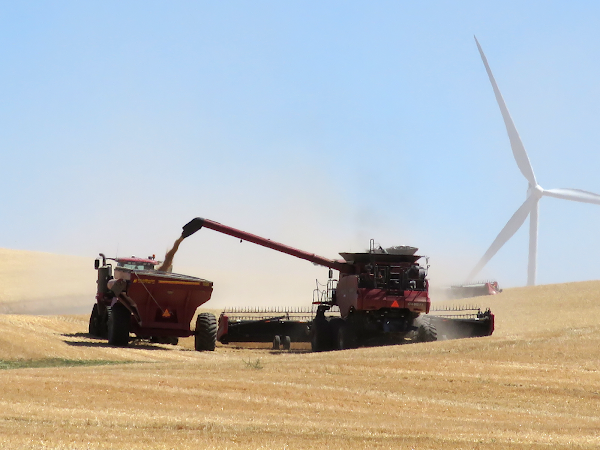On Friday August 12 we took a ride around parts of Walla Walla Country. The wheat harvest is mostly finished in the western portion of the county but over toward the eastern side and in the higher elevations it is still ongoing. We decided to go have a look. The map shows our route with most of the images being taken in the upper right side of the map.
This is a picture of the upper end of Johnson Hollow Road. It pases by Covello which we had posted about earlier. The road is paved closer to highway 12 then as it wanders up the hollow it turns into a decent gravel road and a short ways past Covello it becomes an increasingly narrow gravel track. At one point in the upper end we came to a fork in the road and took the road least traveled, always the most interesting route.
Not far past Covello there were a few trees and amongst the trees was a large flock of Common Ravens. There were at least 34 Ravens that we counted and probably more that we missed. We could not see any reason for the gathering. By the way, a large group or flock of Ravens is sometimes called an “Unkindness”. Who makes these things up anyway?
This is a field of Chickpeas or Garbanzo Beans. They are the same plant but with two different names. As you will see they are planted, allowed to grow during the year, then allowed to dry and finally harvested in the late fall. Chickpeas are used to make hummus. In the distance you can see the wheat being harvested, we will get to that in a moment.
The above image showed a wider view of the chickpea field and here we are looking a little closer.
Closer still we can see the individual plants and the beans. Chickpeas are in the Fabaceae (legume) family, related to soybeans, snap beans, peas, peanuts and many others. They are the third most widely grown legume in the world, after soybeans and beans.
In this image we see the dried husk of the chickpea and a couple of the actual chickpeas. There is generally one chickpea in each husk.
We are up in a higher elevation where the windmills spin. We saw this Red-Tail Hawk riding the currents looking for lunch. This Red-tail could use a little work on feather management, it seems to be missing some feathers.
This is a large wheat harvesting operation. There are several harvesters and associated bank out wagons that take the grain from the harvester and transfer it to a large truck for transport to the grain silos. We are probably viewing a commercial harvesting operation where you pay a company to harvest your wheat field. Each of the harvesters costs approximately $750,000 to $1,000,000 new. That price would include the leveling system enabling the harvester to tilt to follow the contour of the steep ground and the header, the wide part that cuts the wheat.
We are looking closer at the harvesters cutting the wheat. The long lines you see behind the harvester in the wheat chaf and it will most likely be baled and used for various purposes.
Here we see the wheat being transferred from the harvester to the bank out wagon. Oftentimes the transfer will occur as the harvester is moving along and cutting the wheat. One of the large harvesters will hold about 300 bushels of wheat and if the wheat is cutting at 75 bushels an acre you need to empty the harvester fairly often. Additionally some of the wheat fields in this part of the country are fairly steep so you must be conscious of the weight in the harvester lest it starts sliding on the steep hillside.
This is just an interesting image showing the wheat harvester against the backdrop of the windmills.
We hope you enjoyed this brief look at the wheat harvest and the Chickpeas getting ready for your next batch of hummus. We rather enjoyed the outing along Johnson Hollow and other parts of the country and seeing all the activity.
Let us know if you have any questions.
All the best - Be Well - George and Deanna












Any idea what kind of wheat that might be?
ReplyDeleteI am not sure what kind of wheat they are harvesting but in general there are 6 different types of wheat grown in the Walla Walla area:
ReplyDeleteHard Red Winter Wheat
Hard Red Spring Wheat
Soft Red Winter Wheat
Durum Wheat
Hard White Wheat
Soft White Wheat
The most common type of wheat grown in Walla Walla is soft white wheat, which accounts for about 80% of the wheat grown in the area. Soft white wheat is used for making pastries, cookies, crackers, and Asian delicacies. The other types of wheat are grown in smaller quantities, but they are also used for a variety of purposes. For example, hard red winter wheat is used for making bread, hard red spring wheat is used for making pasta, and durum wheat is used for making pasta and couscous. Thanks for the comment - Be well
Fun blog! Wow! chickpeas are fascinating...The extra information about different kinds of wheat is inspiring. Thank you sooo much!!
ReplyDeleteAs always, wonderful post. I learned a lot! Your ability to capture birds in flight is beautiful, but my favorite image in this post was the last one. Thanks for showing us so much beauty and making it interesting!
ReplyDeleteThanks for your comments - My favorite image is the last one as well - that is a very interesting image - be well
Delete